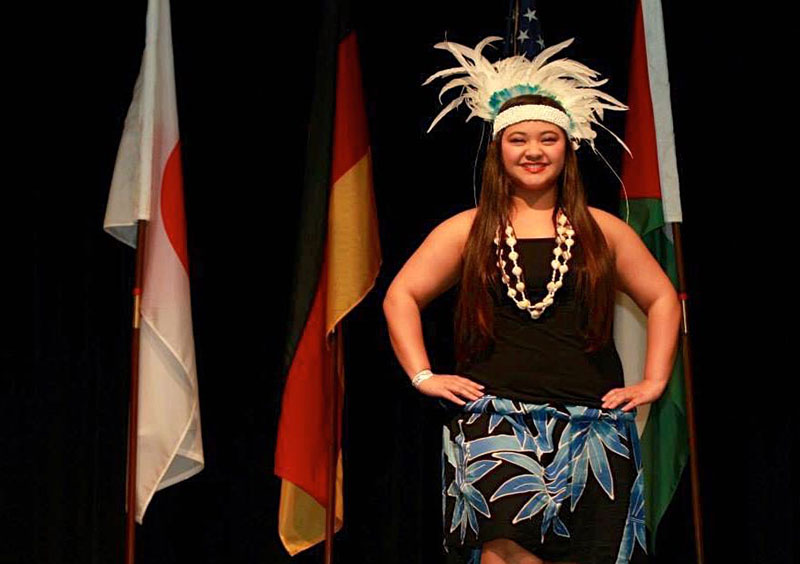Should cultures serve as costumes?
Provided by Anna Rose Guerrero
Anna Guerrero, a Pacific Islander, speaks out against cultural-based Halloween costumes, including the stereotypical grass skirt that is often associated with her culture. She is pictured above in her native culture attire.
The moment that Anna Rose Guerrero saw a student fully adorned in a bright bundle of headdress feathers, fringe and face paint on a stage at a high school Halloween costume contest, she realized something wasn’t right.
Guerrero, a Pacific Islander who lived in Saipan at the time, began to think about the lack of understanding that the student and herself actually had about the Native American culture.
“Nobody told me that wearing such costumes wasn’t okay,” Guerrero said. “But it clicked that it wasn’t right, especially since none of us know anything about Native American Indians. It just seemed like [the contestant] was making fun of a whole group of people.”
Appropriating cultures through Halloween costumes is a common occurrence, according to Professor Sharlotte Neely, who founded the Native American Studies minor at NKU.
“I see children, men and women every year who dress up in a culturally-based costume,” Neely said. “I think that it is so popular because people don’t even give it a second thought. They don’t mean to be malicious, but it never occurs to them that it might not be okay.”
There is a costume dedicated to nearly every minority culture in America explained Guerrero, who is a senior acting major. She then continued to list a few examples including geisha’s, hula dancers and Arab Sheiks.
As someone who is a part of a minority culture, Guerrero believes these costumes are offensive. She lists many reasons as to why this is such as intruding on a culture’s identity, lack of cultural empathy and sexualizing and fetishizing those of various ethnicities.
“Trying to sexualize a culture through these costumes just needs to stop,” Guerrero said. “When you are sexualizing a Japanese kimono by wearing it with a slit up the side, it is like you aren’t even trying to act like you know anything about the culture.”
Neely also touched on the problem with representing a culture through provocative costumes. She explained that the core problem is that they are representing a culture, whether or not they know anything about it. Therefore, when women wear a stereotypical “Indian Princess” costume that is low cut and tight, they are portraying Native American women as one dimensional.
On the flip side, Neely explained that the versions of the Native American warrior costumes for men go beyond insulting a culture. It also perpetuates further stereotypes about men and women.
“At the most basic level, it is just hurtful,” Neely said. “If you are male, you get these tough options and if you are female your only real option is to be sexy.”
Educating people about the meanings of cultural attire is one way to address insensitive costumes, especially since Guerrero believes most people don’t mean to harm or offend people.
However, according to Guerrero, it can come of off as inconsiderate and ill-informed. Thus, she advises people who are thinking about wearing such costumes to put themselves in someone of that culture’s mindset.
“Even if the intention is completely innocent, it looks like you are being cruel and insensitive,” Guerrero said. “They should care about educating themselves about that. Then they will be more inclined to genuinely understand and accept a culture, and it is less from a place of ridicule.”
When it comes to dressing up in a cultural costume, senior sociology major Caroline Walker thinks that there is a fine line between paying homage and disrespecting a society.
“It is hard to determine what is acceptable and what is offensive,” Walker said. “Every detail in the clothes that Native Americans are wearing means something special. Therefore, if you are buying a Native American costume at Walmart, obviously they are not taking the time to replicate those intricate and meaningful details.”
Offensive costumes can go beyond those who are mocking or ignorant of a culture, according to Walker.
“I also find it disgusting when people dress up in religiously offensive costumes like nuns,” Walker said. “It even extends to other areas, like Caitlyn Jenner for example, that costume, which is made for men, portrays an awful outlook on the trans community. I don’t find it funny. I think it looks dumb when people don’t bother to think who they are offending.”
The problem isn’t whether or not these costumes should be banned, but instead it is about being considerate about other cultures. Neely said it is more than just being politically correct; it is about opening up and appreciating other cultures.
“In general, I wish that people would consider that they might even be offending someone,” Neely said. “I think there should be some level of education, just to provide insight and gently let other people know the issues with it. I still think that most people don’t know that what they are doing is wrong, and that is why it still happens.”


